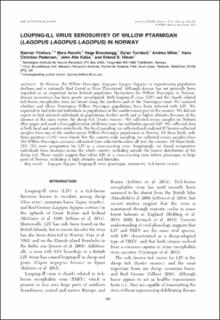Louping-ill virus serosurvey of willow ptarmigan (Lagopus Lagopus Lagopus) in Norway
| dc.contributor.author | Ytrehus, Bjørnar | |
| dc.contributor.author | Rocchi, Mara | |
| dc.contributor.author | Brandsegg, Hege | |
| dc.contributor.author | Turnbull, Dylan | |
| dc.contributor.author | Miller, Andrea L. | |
| dc.contributor.author | Pedersen, Hans Christian | |
| dc.contributor.author | Kålås, John Atle | |
| dc.contributor.author | Nilsen, Erlend Birkeland | |
| dc.coverage.spatial | Noreg, Norge, Norway | en_US |
| dc.date.accessioned | 2022-08-10T07:10:34Z | |
| dc.date.available | 2022-08-10T07:10:34Z | |
| dc.date.created | 2021-01-27T14:45:09Z | |
| dc.date.issued | 2021 | |
| dc.identifier.issn | 0090-3558 | |
| dc.identifier.uri | https://hdl.handle.net/11250/3010961 | |
| dc.description.abstract | In Norway, the Willow Ptarmigan (Lagopus lagopus lagopus) is experiencing population declines and is nationally Red Listed as Near Threatened. Although disease has not generally been regarded as an important factor behind population fluctuations for Willow Ptarmigan in Norway, disease occurrence has been poorly investigated. Both louping-ill virus (LIV) and the closely related tick-borne encephalitis virus are found along the southern part of the Norwegian coast. We assessed whether and where Norwegian Willow Ptarmigan populations have been infected with LIV. We expected to find infected individuals in populations in the southernmost part of the country. We did not expect to find infected individuals in populations further north and at higher altitudes because of the absence of the main vector, the sheep tick (Ixodes ricinus). We collected serum samples on Nobuto filter paper and used a hemagglutination inhibition assay for antibodies against LIV. We collected data at both local and country-wide levels. For local sampling, we collected and analyzed 87 hunter-collected samples from one of the southernmost Willow Ptarmigan populations in Norway. Of these birds, only three positives (3.4%) were found. For the country-wide sampling, we collected serum samples from 163 Willow Ptarmigan carcasses submitted from selected locations all over the country. Of these birds, 32% (53) were seropositive for LIV or a cross-reacting virus. Surprisingly, we found seropositive individuals from locations across the whole country, including outside the known distribution of the sheep tick. These results suggest that either LIV or a cross-reacting virus infects ptarmigan in large parts of Norway, including at high altitudes and latitudes. Lagopus lagopus, louping-ill virus, ptarmigan, serosurvey, tick-borne viruses. | en_US |
| dc.language.iso | eng | en_US |
| dc.subject | Lagopus lagopus | en_US |
| dc.subject | louping-ill virus | en_US |
| dc.subject | ptarmigan | en_US |
| dc.subject | serosurvey | en_US |
| dc.subject | tick-borne viruses | en_US |
| dc.title | Louping-ill virus serosurvey of willow ptarmigan (Lagopus Lagopus Lagopus) in Norway | en_US |
| dc.type | Peer reviewed | en_US |
| dc.type | Journal article | en_US |
| dc.description.version | publishedVersion | en_US |
| dc.subject.nsi | VDP::Zoologiske og botaniske fag: 480 | en_US |
| dc.subject.nsi | VDP::Zoology and botany: 480 | en_US |
| dc.source.volume | 57 | en_US |
| dc.source.journal | Journal of Wildlife Diseases | en_US |
| dc.source.issue | 2 | en_US |
| dc.identifier.doi | 10.7589/JWD-D-20-00068 | |
| dc.identifier.cristin | 1880455 | |
| dc.relation.project | Egen institusjon: Norwegian institute for nature research (NINA) | en_US |
| cristin.ispublished | true | |
| cristin.fulltext | original | |
| cristin.qualitycode | 1 |
Tilhørende fil(er)
Denne innførselen finnes i følgende samling(er)
-
Publikasjoner fra CRIStin - NINA [2364]
-
Scientific publications [1392]
Vitenskapelige artikler, kapitler og monografier i Open Access.
